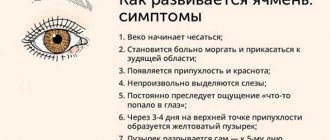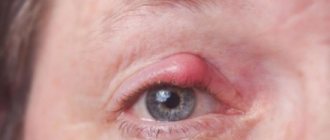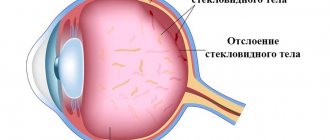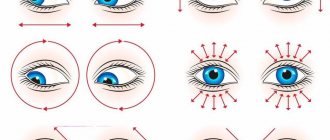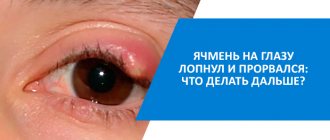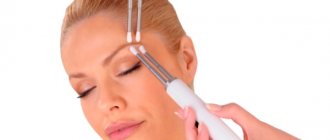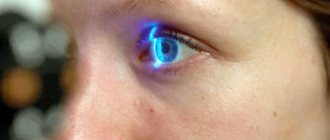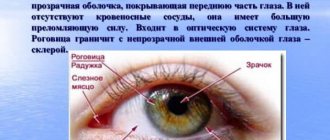How does hordeolum manifest itself, and what distinguishes it from other eye diseases? What does stye look like on the eye (photo)? The answers to these questions can be found in this article.
When the root of the eyelash hair follicle becomes inflamed, a stye forms on the eye. Scientifically, this disease is known as hordeolum. It can pop out on both the upper and lower eyelids, and can be external or internal.
The unpleasant symptoms caused by purulent inflammation are probably known to almost everyone. But many people mistakenly call other inflammatory eye diseases stye.
First aid
If preventive measures do not help, and the eyelid begins to turn red and itch, you need to start treatment.
At the first manifestations of hordeolum, you can save the situation with the help of iodine, brilliant green or alcohol. You should first disinfect your hands, and then carefully cauterize the area of redness with iodine/green paint. You can put antibacterial eye ointment in the conjunctival sac. Until pus appears, dry heating can be carried out. To do this, apply a boiled moderately hot egg to the eyelids (do not peel) or heat a linen bag with salt in a frying pan and warm it up. Instead of eggs, use jacket potatoes, and instead of salt, use flax seeds. The egg and potato are wrapped in clean cotton cloth. If you do not miss the time, such procedures completely stop the development of inflammation.
If these methods do not help, ophthalmic ointments are used to stop the development of suppuration:
- Acyclovir;
- Levomekol;
- Tetracycline.
Ophthalmic drops are also used in combination with ointments:
- Tobrex;
- Albucid;
- Levomycetin.
If the abscess begins to mature, then aloe/kalanchoe juice can help quickly open it. The bottom leaf of aloe is thoroughly washed and crushed. Squeeze the juice out of the resulting mass through gauze and lubricate the eyelid with the healing liquid. You can soak a cotton pad in the juice and apply it to the sore eye.
To reduce itching, you can wash the eyelid with cool decoctions of medicinal herbs:
- chamomile;
- sage;
- plantain.
It is strictly forbidden to warm up the suppuration. Washing the eyelid is carried out with cool infusions, not higher than room temperature. Heating the source of inflammation promotes the spread of infection to adjacent healthy tissue.
Multiple stye cannot be treated at home, as self-medication will lead to serious consequences. The same applies to internal stye, which forms on the inside of the eyelid. These pathologies are treated with strong antibacterial drugs, and sometimes surgical procedures are required.
To strengthen the immune defense, you need to take immunomodulators or restoratives. Echinacea (tablets, alcohol solution) improves immunity well. You can buy a special liquid for applying therapeutic compresses to the affected eyelid. The compress will increase local immunity, and echinacea in tablet form strengthens the overall immune status. However, the use of echinacea must first be discussed with an ophthalmologist; in some cases, its use is unacceptable.
To increase immunity and destroy infection in the body, propolis tincture is used. You can prepare a water infusion yourself, or you can purchase an alcohol tincture from a pharmacy. Drops are diluted in water/milk and taken orally. However, the drug is allergic, so you need to be sure that the body can tolerate propolis. At the first symptoms of allergy (tissue swelling, pain, rash), treatment with propolis should be stopped.
How to cover up a bruise from an injection after a cosmetic procedure
Bruises that occur after cosmetic procedures, for example, after botulinum therapy or injection of hyaluronic acid fillers, are not as extensive as damage caused by a blow. Small blue dots from the needle are easy to cover up. The technique for applying cosmetics is standard
A:
- Cleansing the skin and using a skin care product.
- Application of primer.
- Spot use of the corrector with careful shading of the product a few millimeters beyond the boundaries of the damaged area.
- Using foundation and, if necessary, concealer.
- Powdering the face.
Small bruises from injections do not cause much inconvenience to women and disappear within 2-4 days; after 2-3 days the need to cover up the injury site may disappear, since the hematoma is not visible under a layer of regular foundation.
Prevention of stye
Prevention of barley is to follow the rules of personal hygiene, wash your hands and, if they are contaminated, do not touch your eyes with them. Also, all products used for eye care and cosmetics must be strictly individual.
If inflammation recurs frequently, you should take a course of multivitamins, which will help strengthen the immune system.
For the purpose of prevention and in case of frequent occurrence of the disease, doctors recommend adhering to a certain diet, namely eating more fresh vegetables and fruits, drinking more freshly squeezed juices.
You can also regularly use a diet with the following products:
- fresh vegetables and fruits;
- yogurt;
- fruit juice;
- Herb tea;
- mineral water.
This diet must be followed for a week and repeated at certain intervals.
What does barley look like?
The common name for this infectious process is associated with the appearance of a ripe boil: it resembles a grain of barley.
At the initial stage, the pathological process is expressed in redness of a limited area of the eyelid, the touch of which causes pain.
When the boil matures, it looks like a lump with a white, purulent point at the top.
Clinical picture of hordeolum:
| Stage | Symptoms |
| Initial (infiltration stage) | The formation of a small swelling the size of a grain. Touching her hurts. Mild itching or burning may occur. The initial stage lasts 1–3 days. After this, either self-healing occurs or the pathological process progresses. |
| Suppuration period | A capsule with pus is formed around the inflamed eyelash hair follicle. Sometimes it opens on its own and the contents come out. But in some cases surgery is required. At the stage of suppuration, a round white compaction forms on the edge of the eyelid. This is the capsule. When barley suppurates, symptoms of intoxication are also observed: increased body temperature, increased size of lymph nodes |
| Cyst breakthrough | The contents of the capsule come out, its volume decreases, and the patient feels relief: the pain disappears, the temperature returns to normal levels |
| Healing | A crust forms on the surface of the ruptured capsule, under which healing occurs |
Symptoms and causes of stye
Why can staphylococcus become active:
- Due to hypothermia of the body. Most often it appears after a person gets his feet wet, gets caught in the rain or the wind blows in his face for a long time, even worse if there is dust.
- It can also be activated due to decreased immunity. In this case, barley may appear regularly. Here you should carry out hardening procedures, you can use cool eye baths. You should monitor the frequency of colds, a sufficient amount of vitamins in the body, and also avoid stress.
- For women, it is recommended to use high-quality cosmetics with a normal shelf life.
- Direct infection into the eye is possible if personal hygiene is not maintained. Poorly washed hands, which are then used to rub the eye (especially in children), can cause inflammation. You should also monitor the cleanliness of face towels and hygiene products for eyelashes and eye care. You should not use other people's cosmetics and towels.
- Barley can occur due to the ingress of a mite that settles in the eyelashes (Demodex).
- In those people who suffer from diabetes, seborrhea, chronic blepharitis, stye can occur very often as a consequence of the disease.
In any case, determining the cause should be entrusted to the doctor, who will prescribe the necessary tests, and then treatment.
The following signs can be considered symptoms of the initial stage of barley:
- swelling of the eyelid;
- redness;
- pain and burning.
In the future, a white pustule may form. There may also be an increase in temperature and enlargement of the lymph nodes that are located nearby.
After some time, the abscess may open on its own, or it may simply resolve. In any case, nothing should be squeezed out, since it is possible to introduce an infection and worsen the patient’s condition, up to the development of meningitis, sepsis or phlegmon of the eye.
Common interpretations of signs
The main interpretations of signs about barley on the eye are associated with magic. The ancient Slavs were also sure that a purulent lump on the eyelid indicated damage or the evil eye. What kind of impact was provided depends on the location of the source of inflammation:
- if it is on the left eye, it means that the one who caused the damage is very strong and will certainly continue to do evil;
- barley jumped up on the right - the ill-wisher did not manage to greatly harm his victim.
There is another interpretation of the folk sign about stye on the eye. Esotericists associate the development of the inflammatory process with the destructive effect of bad thoughts that have settled in the head of the sick person.
What complications can occur if you do not start treatment on time or use the wrong methods?
Doctors never tire of reminding us how important it is to contact specialists on time and how many consequences could be avoided if a person started treatment on time. Unfortunately, many begin to act according to their own understanding, relying on the advice of friends or finding recommendations on the Internet, and sometimes believing that the abscess will go away on its own.
This attitude is a common reason why hordeolum can end in complications. Only early therapy can quickly and effectively defeat most diseases. You need to see a doctor as soon as possible. These are the consequences that seemingly not so dangerous at first glance barley can cause.
- Phlegmon of the orbit. This is a purulent inflammation of the retina followed by its melting. Phlegmon develops very quickly and threatens with dangerous consequences. It can cause blurred vision, and in other cases lead to optic nerve atrophy.
- A chalazion is a hard formation under the upper or lower eyelid that occurs as a result of blockage of the meibomian glands. If left untreated, it gradually grows, increasing in size. Several such seals may appear. Chalazion can also lead to blepharitis, and in children, as a result of pressure on the cornea, it can cause astigmatism and distorted vision. The tumor may eventually become so dense that it will only have to be removed surgically.
- Vascular thrombophlebitis occurs when pus spreads into the vessels of the eye. The whites turn red and vision becomes worse.
In addition to damage to nearby tissues in the eye, stye can cause more serious complications.
- Meningitis. Often occurs against the background of developed phlegmon. This is an inflammatory process that occurs in the lining of the brain. Meningitis is a very short-lived disease and can be fatal within a few days.
- Sepsis. It may occur against the background of chronic stye on the eye or the entry of purulent masses into the blood. It greatly weakens the immune system, and the body is unable to cope with inflammation. With sepsis and meningitis, general weakness, high fever, and headaches occur. If you feel these signs during the appearance of barley, you should immediately consult a doctor.
We have listed just a few complications that can arise from hordeolum. In fact, there are many more of them, all of them will cause harm to health, unfortunately, in other cases - irreparable.
How to treat stye on a child's eye
Styes on the eyelid of a child occur quite often. This is because babies may unknowingly rub their eyes with dirty hands. Moreover, the pathology can be bilateral, since a child can easily transfer the infection from the source of inflammation to the healthy eye simply by touching the sore spot.
Treatment for the disease is similar to that received by adults. But only a doctor can prescribe medications or choose traditional medicine methods.
Moreover, in addition to the chosen therapy, the child needs to be comprehensively examined to understand what triggered the pathology - reduced immunity, helminthic infestations or high sugar levels.
How to treat quickly at home
Styes on the eye can be treated at home if there are no severe complications and the patient’s condition does not worsen. To quickly cure the disease, you need to accelerate the maturation of the abscess, provoking its breakthrough. As already mentioned, it is impossible to open the tumor mechanically - in this case, herbal compresses help. All medicines that have no side effects already exist in nature. If for some reason the patient does not see a doctor, it is necessary to use effective folk remedies. As a rule, exacerbations and complications are extremely rare, so treatment at home is quite acceptable. It can last from 3 to 7 days.
When the disease first started:
- In the first hours of maturation of the abscess, it is necessary to maintain hygiene. With clean hands, treat the eyelid with iodine solution or an alcohol-based antiseptic. An alcohol compress helps only at the stage of maturation of the abscess.
- Prepare a pale pink solution of potassium permanganate and rinse your eyes with it for 24 hours.
Treatment of internal stye
Suitable treatment for internal stye is determined by a specialist - an ophthalmologist. He conducts a preliminary examination and determines the complexity of the disease. For each patient, therapy is selected individually depending on the physiological characteristics of the patient’s body and the nature of the disease.
Often medications are prescribed to treat meibomitis. But additional treatment can be used to speed up recovery.
Use of ointments
Treatment of internal styes on the lower and upper eyelids is often carried out using special ointments. They should be prescribed only by an ophthalmologist according to the indications and course of the disease.
For meibomitis, the following external remedies can be used:
- Tetracycline ointment. This is a safe and effective external remedy, during the use of which no burns are formed on the surface of the mucous membrane and cornea. The ointment is recommended to be used from the first day of detection of the disease until it disappears. Apply to the inner surface of the eyelid 3 times a day;
- Phloxal. This remedy is considered effective and safe, it can be used for meibomitis. The ointment can be used by adults and children;
- Hydrocortisone ointment. The drug is recommended for severe forms. It should be applied as a compress to the eyelid area. It is recommended to use up to three times a day.
Ointments for internal barley
Treatment with drops
Internal styes of the lower and upper eyelids can be treated with eye drops. They can be used additionally together with ointments. Drops eliminate inflammation and have a disinfecting effect.
Particularly popular among drugs in the form of drops for the treatment of meibomitis are:
- Albucid. These are the most affordable drops that help eliminate a number of infectious eye diseases, including internal stye. However, they can cause itching, burning, and increased tearing;
- Tobrex. The product has a direct effect on the area of inflammation. Active substances attack the infection and accelerate the resorption of the abscess;
- Gentamicin. Drops are often prescribed in severe cases when other drugs have not helped eliminate the disease.
Drops for internal stye
Physiotherapy
Various physiotherapeutic procedures help eliminate early forms of internal stye. They can also be used as a supplement in the treatment of advanced internal stye.
The following physiotherapy methods are often used:
- Microwave therapy;
- Irradiation with ultraviolet rays;
- Electrophoresis;
- Dry air shower.
Folk remedies
For internal barley, folk remedies can be used. They help quickly eliminate pain, speed up recovery and improve overall condition. Folk remedies do not have harmful effects and have no contraindications, so they can be used independently without a doctor’s prescription.
The following are considered the most effective:
- Lotions with calendula. Add 1 tablespoon of calendula flowers to a glass of hot water. Let it sit for about an hour. It is recommended to make lotions from the tincture 2-3 times a day. The duration of each session is 15 minutes.
- Aloe. The leaves of the plant must be cut into small pieces and filled with hot water. The mixture is infused for 10 hours. Next, it is applied to the affected area several times a day.
- Applying heated salt. Table salt needs to be heated a little in a frying pan over a fire. Next, it is transferred to cotton fabric and wrapped. After this, it is applied to the sore area and left until it cools completely.
Which drops are best to choose?
An ophthalmologist will help you choose the right drops against stye. Do not follow the advice of your friends: what has helped others may not work for you, and even worse, if it does harm. This is especially true for children; do not experiment; a small body is more difficult to tolerate all diseases.
If going to the doctor is absolutely not possible, it is better to consult a pharmacist at the pharmacy. He will tell you which drops are more effective in helping with stye on the eye and how to instill them. After purchasing the drug, look at the expiration dates, read the instructions, and strictly follow its instructions. Do not exceed the dosage or frequency of instillation; it will not be possible to speed up treatment in this way.
If you notice that the drug does not help, your condition is worsening, or you have been sick for more than a week, immediately consult a specialist, you don’t joke with your health.
Folk remedies
There are a large number of folk recipes for treating barley; the most popular option is the use of tea leaves. It is enough to brew strong tea and then rinse your eyes with the resulting infusion.
Consequences of improper treatment. If the stye is not treated, it will most likely go away on its own in 4-6 days. Folk remedies can prevent the development of the disease or accelerate the maturation and cleansing of the abscess. The danger arises only if it is treated incorrectly or diagnosed incorrectly. Do not squeeze out the purulent contents - the infection can spread through the blood vessels, which can lead to meningitis or blood poisoning. Making a diagnosis is also very important; you need to make sure that it is not a chalazion, tumor or cyst.
Simple folk remedies will help you quickly cure barley; some of them will help get rid of barley in 1 day.
Stye on the eye should be treated at home at the very beginning of the disease, when the stye is just beginning to grow, in order to prevent the development of the disease. But if barley has already appeared on the eyelid, then treatment with folk remedies will help speed up the maturation of the abscess, this will reduce the duration of the disease from 5-6 days to two days.
Compresses.
Warm compresses in folk remedies are used if stye has already appeared on the eyelid. Heat helps the abscess to quickly mature, after which the pus will come out and the eyelid will return to order. Warming up at the first symptoms will stop the development of the disease and reverse the process.
- Recipe 1 - boiled egg for barley: warm boiled egg to your eyelid With this method, you can treat stye at home quickly; to do this, you need to repeat this procedure every hour. For the next procedure, you don’t need to boil a new egg, but boil the same one. Keep this compress until it cools down.
- Recipe 2 - herbs for barley: brew a pharmaceutical bag of bactericidal herbs (chamomile, calendula, string, eucalyptus, sage) or green tea with 100 ml of boiling water. Apply a warm bag to the eyelid 3-4 times a day. To speed up recovery, you can also use a warm gauze compress soaked in an infusion of these herbs.
- Recipe 3. Dry heat will help to quickly cure stye on the eyelid: fill a small bag with flaxseed , heat it in the oven and apply it to the eyelid - the inflammation will go away. You can make it simpler - heat the flax seed in a frying pan, add 1 tbsp. l. into a clean handkerchief, tie it in a knot and apply it as well.
Aloe.
Aloe for barley is the most painless and effective remedy. Squeeze the juice out of a clean aloe leaf, moisten a napkin and apply it to the eyelid - everything will go away quickly. Or simply hold a piece of aloe with a cut on the damaged area.
Propolis tincture.
If the first symptoms of purulent inflammation appear, the barley is just beginning to grow, then you need to cauterize the sore spot with a cotton swab dipped in propolis tincture 4-5 times a day, being careful not to get on the cornea. The inflammation will stop, in the morning there will be no traces left. Tested many times. (Recipe from the newspaper “Vestnik ZOZH” 2011, No. 2, p. 31)
Treating stye at home with saliva.
Saliva successfully helps to get rid of stye on the eye. This method should be used immediately upon feeling the first signs. Lubricate the sore spot with saliva as often and as abundantly as possible. Hungry saliva is more healing. If you start the procedure immediately, suppuration will not begin. If pustules have already appeared, treatment will not take hours, but one or two days. The pustules will somehow disappear imperceptibly. The eye will turn red from the abundant saliva and will sting, but this is not scary and will not last long. The main thing is to protect the abscess from cold and wind, so as not to aggravate the disease. The effect of saliva is understandable. It contains a strong antimicrobial agent, lysozyme. Previously, even ophthalmologists recommended this method.
Treatment of old barley with honey.
If the abscess on the eyelid is old and cannot break through, then this method will help remove the stye: with clean hands, knead the dough from flour and honey, make a cake and apply it to the eyelid overnight, tying it with a scarf. If the abscess does not break through, then apply the same compress the next night. This method works 100%. Boils can be treated in the same way. (Home remedy from the newspaper “Bulletin of Healthy Lifestyle” 2009, No. 22, p. 29)
Read also…. Adenoviral eye infection
A boiled egg for barley is a simple folk remedy.
- Since childhood, women have often had styes, either on the lower or upper eyelid; various folk remedies were used for treatment, as well as dietary supplements with yeast, and even blood transfusions. But nothing helped get rid of them forever. One day, a neighbor advised me to apply a hot boiled egg wrapped in a cloth as soon as my eye itched. Keep the eggs until they cool completely. The woman used this egg recipe three or four times. After this 40 years there are no more problems. (Recipe from the newspaper “Vestnik ZOZH” 2006 No. 8, p. 30)
- As soon as you feel that your eye is itchy and red, your eyelid is inflamed and hurts, immediately boil an egg, peel it and apply it hot to the sore spot, only be careful not to burn it. Sometimes, just once is enough for the disease to stop before it even starts. The reader was advised by a doctor to heat barley with an egg, but only at the very first symptoms.
Treatment with glycerin.
If your eye begins to itch and your eyelid turns red from the inside, it means you need to take immediate action. Glycerin will help get rid of barley at home. Apply a drop of glycerin to the sore spot inside the eyelid, then release the eyelid and rub lightly. The abscess will not appear, everything will pass quickly, in 1 day.
Thread treatment.
If a stye appears on the eye, then on the hand opposite the eye you need to bandage the middle and ring fingers with a figure of eight woolen thread. This folk remedy, although very strange, but the thread quickly helps get rid of barley - sometimes in 1 day. The newspaper describes a case where a man had multiple abscesses on his eyelid; he was advised this method, but he didn’t believe it. But when the pain became unbearable, I used it. The pain immediately began to subside, and in the morning the illness was almost gone. The effectiveness of this method is somehow related to Su-Jok therapy. It was used in Rus' for a long time, and the eldest member of the family had to tie the fingers with thread.
Childhood and youth
Publius Ovid Naso was born in the city of Sulmo (modern Sulmona), located in the Apennine Valley east of Rome on March 20, 43 BC. in a family belonging to the class of equites (horsemen). The position of the parents of the future poet in society was quite high; according to their property status, they had the right to make trade transactions and were part of the business stratum of the city elite, and their children had the privilege of receiving an education.
Monument to Ovid in Sulmona, Italy
Following his father’s wishes, Ovid and his brother began to study rhetoric from Arelius Fuscus and Marcus Porcius Latron, masters of oratory of the Ancient Roman Empire. Following an emotional, rather than reasoned, style of conducting conversations and arguments, the future lyricist did not want to master the techniques necessary for the legal practice destined for him. After dropping out of school, the young man went traveling and visited Athens, Asia Minor and Sicily.
In his youth, Ovid held minor public positions, was a member of the centumvira, the college of civil affairs, and was also a member of the decemvira department, which performed spiritual and secular duties at the state level.
Portrait of Ovid
Around 29-25 BC. the young man realized that imperial service was alien to his nature and character, and resigned, upsetting his father and other family members. At this time, Ovid was attracted to literature, and he, succumbing to the temptation to become a famous poet, joined the circle of the elite under the patronage of Mark Valery Messalus Corvinus. The first speech of the novice elegist is dated approximately 25 BC, from this moment scientists count down the creative biography of Ovid.
Treatment of barley in a child with drops
A stye on a child’s eye (the doctor will tell you how to treat it at home) can be eliminated by various means. The choice of treatment form is eye drops, which in their composition combine antibiotics and pain relief.
Antibiotic exposure is necessary to fight infection, destroy pathogens and pathogens that cause inflammation of the eyelid
Pain relief is important for the child, as stye causes pain
The table shows the most effective eye drops for treating children:
| Name | Action | A course of treatment | Security measures |
| Tobrex |
| 1 drop in the inner corner of the eye 5 times a day | keep the dose |
| Levomecithin |
| 1 drop in the inner corner of the eye 3 times a day | overdose may cause kidney problems |
| Sulfacyl sodium |
| 1-2 drops 6 times a day in each eye and even in a healthy one to prevent the occurrence of any eye diseases | an overdose will cause itching and irritation of the eye mucosa |
Important to remember! It is necessary to strictly follow the dosage when using drops, carefully read the recommendations for use, which are in each box of medicine. The process of treatment with barley drops in a child:
The process of treatment with barley drops in a child:
Read the instructions, precautions, take into account the dosage in accordance with the age of the child. Sometimes eye drops need to be shaken before use. Before use, hold the drops in your hands and warm them to body temperature. An adult should wash their hands with soap, then disinfect them with an antiseptic (Dettol, Velvet Hands hand gel) or any alcohol solution. A child in a sitting or lying position throws his head back. Pull back the eyelid and drop (the number of drops is dosed according to the instructions). Ask the child to close the eye and open it several times so that the medicine is distributed throughout the eyeball.
Attention! Never rub your eyes or wipe off excess medication with your hands - use a clean, dry cloth.
Diagnostics
You can diagnose the disease yourself, but if the disease lasts for a long time, and to avoid dangerous consequences, it is advisable to see a specialist.
A visual examination is carried out using eversion of the eyelids, illuminating the stye on the eye from the side. Other examinations are not usually used. With frequent relapses, consultations with doctors of other specializations may be necessary: endocrinologist, gastroenterologist, dermatologist. To determine the cause of frequent relapses, blood and urine tests, testing for demodicosis, helminthiasis, and bacteriological culture of the conjunctiva may be prescribed.
Useful video
External differences from other eye diseases
Barley is often confused with other purulent eye infections.
Attention! Diagnosing the disease yourself can be difficult! A doctor who is well acquainted with the symptoms of eye diseases will help prevent annoying mistakes in treatment. Among them are the following diseases:
Among them are the following diseases:
- Chalazion. The infection affects the inner edge of the eyelid. Swelling and redness on the eyelid or conjunctiva are localized. Purulent crust occurs extremely rarely. The purulent head of barley is always covered with a crust.
- Blepharitis. During inflammation, eyelashes stick together and crusts form on the eyelids. In both cases, swelling, redness, and swelling appear.
- Demodecosis. The disease provokes the development of blepharitis or barley. It is accompanied by loss, sticking of eyelashes and the appearance of a weeping plaque along the edge of the eyelid. Both diseases cause severe swelling. With demodicosis, morning swelling disappears completely during the day. It is usually provoked by kidney disease, liquids drunk before bed and the use of cheap and unsuitable beauty products.
Description
Barley on the eye is a limited purulent inflammation of the hair follicle of the eyelash or the Zeiss sebaceous gland.
According to statistics, almost every person has encountered this problem throughout their entire life. Most often, the disease occurs between the ages of 20 and 50; barley is not uncommonly diagnosed in children.
Types of stye eyes:
- external – the hair follicle of the eyelash and/or the sebaceous gland of Celsus, which is located near the eyelash bulb, becomes inflamed;
- internal - the lobe of the meibomian gland becomes inflamed.
Barley occurs as a result of bacterial infection, in 90% of cases the source of infection is Staphylococcus aureus. In addition, the source of barley can be a microscopic Demodex mite, which is located on the eyelashes, or fungi.
The following risk factors for the appearance of stye are identified:
- general hypothermia of the body;
- hypo- and vitamin deficiencies;
- endocrine disorders;
- exacerbation of chronic somatic diseases;
- the presence of concomitant ophthalmological pathology (conjunctivitis, blepharitis);
- previous infectious diseases leading to decreased immunity.
It is important to understand that stye on the eye is not only a cosmetic problem, but first of all it is a disease that requires the intervention of a specialist. The lack of necessary treatment can lead to the development of serious purulent-septic complications or to a chronic course of the disease, which is characterized by periodic relapses of the pathological process. Therefore, it is extremely important not to neglect your condition, but to consult an ophthalmologist in a timely manner.
Internal and external
The process of inflammation begins immediately after Staphylococcus aureus bacteria enter the sebaceous gland or hair follicle, resulting in the formation of external barley. The inflammatory process is localized closer to the surface of the epidermis.
Internal stye appears due to blockage of the meibomian glands by infection and, as a rule, settles in deeper layers of tissue, which can cause difficulties in its prevention.
Considering that there are about seventy meibomian glands in humans in the upper and lower eyelids alone, several simultaneous inflammatory processes can be observed at once.
Types of barley
- External stye. This is the most common type of barley. It is an abscess, that is, an abscess on the edge of the eyelid. The abscess matures on the outside of the eye. Its development is caused by infection of surrounding tissues.
- Internal stye. This is an abscess on the inner surface of the eyelid. It develops as a result of infection of the meibomian glands. The Meibomian glands are located in the middle of the eyelid, at the base of the eyelashes. Their number is about 50-70 in each century. These glands help keep the eyes moist by preventing tears from evaporating from the surface. If the meibomian glands become blocked, an internal stye can lead to the development of a chalazion.
Styes can be dangerous if not treated correctly or if the diagnosis is incorrect. Squeezing out pus leads to the spread of infection through the vessels, which can even lead to meningitis or blood poisoning. And here you cannot do without serious treatment.
How to choose the color and consistency of the corrector
The most important thing in the process of masking bruises is the correct choice of corrector. It is this product that visually normalizes the skin color at the site of injury.
Foundation and concealer serve to consolidate the effect, and powder will help to finally even out the tone of the face.
In most cases, a bruise attracts a lot of attention from strangers, since the darkening stands out strongly against the light skin of the face. Therefore, only a concealer with a dense, thick, but soft, pliable and plastic texture, which helps to even out the shade of the skin at the site of the bruise, will help to cover it up.
The most convenient forms of corrector release are stick, pencil, cream. Before purchasing the drug, it is recommended to test it on the skin to understand how well it masks various defects.
It is known that after a bruise appears, it goes through several stages, its color changes from dark (purple, blue) to lighter - greenish, yellow, orange. The same corrector will not be able to cover up the hematoma at each stage
Here it is important to ensure that the color of the corrector covers and levels out the current color of the skin at the site of damage. A beige, nude concealer, even with high coverage properties, may not be suitable for these purposes.
But this type of cosmetic product has a wide palette of shades, from which you need to choose, starting from the color of the bruise:
- Orange concealer will help cover up green, blue, or blue-green bruises.
- The yellow preparation will cover up a purple or dark blue bruise.
- If the hematoma is dark red, you need to use a blue or green corrector.
- When the bruise is at the stage of a brown spot, a green corrector will help cover it up.
- If the bruise has a green tint, then a pink and reddish concealer will help hide its presence on the face.
- When the damage reaches the final stage and the skin begins to turn yellow, a purple corrector will help cover up the defect.
If bruises on your face constantly occur, for example, due to boxing or severe absent-mindedness, as well as a tendency to faint, buy a special corrector palette that includes all the shades of the product that you may need. This set can contain from 4-5 to 15-20 or more colors.
How to behave correctly when treating stye
Women should avoid decorative cosmetics during the treatment period. Otherwise, re-infection and complications may develop.
Use decoctions and infusions several times a day, but do not wipe your eyes, you can only dry them slightly.
During treatment, carefully observe personal hygiene, since barley is an infectious disease that can be transmitted through personal hygiene items - towels, cosmetics, soap, cotton pads, etc.
In addition, the choice of treatment methods depends on the stage of the disease. Therefore, it is best if the treatment is prescribed by a qualified doctor.
Tags: eye stye
Prevention
Complications after barley, as a rule, are not observed. The disease leaves no traces. With proper treatment, recovery occurs fairly quickly.
To avoid re-infection, it is important to follow the following rules:
- Strengthen immunity;
- Do not touch your eyes and face with dirty hands;
- When a stye “pops up”, you should not rub your eyes;
- Use personal hygiene products, including your own towel;
- Wash off cosmetics and monitor their expiration date; do not use cosmetics during the treatment period;
- Do not try to open the abscess yourself;
- Treat eye diseases in a timely manner
- Don't get too cold.
A healthy lifestyle, hardening and proper nutrition will help strengthen the immune system of children and adults, get rid of not only barley, but also many other diseases.
If barley bothers you regularly, then you should be examined for chronic diseases.
How to treat a pimp on the eye
To quickly get rid of barley, you must follow all the doctor’s recommendations. The patient is prescribed a number of medications, vitamins and traditional medicine recipes.
Drug treatment
In most cases, the stye breaks out on its own, and the patient’s condition immediately improves. But if symptoms of intoxication are observed, the patient’s eyelid is very swollen or pus is discharged from the eye, it is necessary to see a doctor.
The treatment regimen includes antibacterial ointments and eye drops that help quickly relieve inflammation:
- Tetracycline or Gentamicin ointment. This is a powerful antibacterial drug that is often prescribed for conjunctivitis and stye. The ointment is placed under the lower eyelid 2-3 times a day. After this, you should massage the upper eyelid a little so that the medicine is evenly distributed.
- Floxal and Tobrex. These eye drops are prescribed for infectious diseases of the visual organs. It is necessary to apply eye drops 3-4 times a day. Floxal can be used to treat even young children.
- Tsipromed. A strong antibacterial drug that is prescribed for barley in severe cases. The medicine has a detrimental effect on many pathogenic bacteria.
- Albucid. These eye drops can also be prescribed for stye on the eyelid. The only drawback of the drug is its side effects. After the medicinal solution gets on the mucous membrane of the eye, a severe burning sensation occurs.
For an abscess on the eyelid, Levomycetin drops help a lot. This is an inexpensive but quite effective drug that helps quickly eliminate inflammation and swelling of tissues.
In addition, the patient is prescribed vitamins and immunomodulators. They are necessary to improve immunity.
To wash the eyes, you must use a solution of Furacilin or Miramistin
It is especially important to treat the eyelid with antiseptic solutions after the abscess has broken through.
The area of the abscess is lubricated with brilliant green or alcohol. The problem area should be treated carefully using a cotton swab.
Traditional methods
You can cure a pimples on the eye using a number of folk recipes. Lotions with decoctions of medicinal herbs, bee products and infusions will help eliminate inflammation:
- Take ¼ cup of chopped chamomile and St. John's wort herbs. Pour boiling water over the plant material, leave for 15 minutes and filter. Use warm to wash the eyes.
- Take 3 tablespoons of St. John's wort flowers, add a liter of water and bring to a boil. After infusion, filter and drink the infusion instead of tea twice a day, ½ cup.
- Fresh cabbage leaves are crushed to a puree and mixed with fresh chicken protein. The resulting mixture is moistened with gauze and applied to the eyelid.
- A little honey is poured onto a saucer. Soak a piece of rye bread in it and apply it to the barley for 4–5 hours; the bread should be secured with an adhesive plaster.
- Squeeze the juice out of a clove of garlic. Soak a cotton swab in it and carefully treat the abscess with the juice. You can mix garlic juice with vodka and treat the head of the abscess with this tincture.
- Aloe juice is diluted with water in a ratio of 1:2, after which the solution is used for lotions.
- Boil an egg and apply it to the problem eyelid for 20 minutes. Such procedures can only be carried out until the abscess has broken out.
You can treat barley with fresh plantain leaves. To do this, wash the leaf, knead it with your hands and apply it to the eyelid for an hour.
If you are prone to allergies, then you should not use folk recipes that contain decoctions of medicinal herbs.
Surgery
If the abscess does not break through for a long time, then surgical intervention is necessary. The doctor pierces the head with a needle or makes a small incision in the eyelid. After the pus has been removed, the cavity is washed with an antiseptic solution. After this, the patient is recommended to use antibacterial drops for 5 days to prevent secondary infection.
In particularly severe cases, systemic antibiotics may be prescribed. Penicillin or macrolide medications are often prescribed. Antibiotics must be taken for at least 5 days. Before taking medications, you should carefully read the instructions.
Folk remedies and recipes
Many people are familiar with this situation: immediately after waking up, suspicions creep in, not unreasonably: “Is it possible that barley is developing?” The first signs appeared: the abscess is not visible, but there is already pain, tingling inside the eyelid, and slight swelling is noticeable. Is it possible to prevent the development of the inflammatory process?
How to remove stye from the eye? There are several proven methods of dealing with this unpleasant phenomenon for treatment at home:
- A simple, affordable method is dry heat. Boil an egg hard, wrap it in a clean cloth or handkerchief, and apply it to the swollen area. Hold until the heat goes away. Instead of eggs, take flax seeds and sea salt. Heat the ingredients in a frying pan and tie them into a knot. Remember - the method is recommended only in the initial stage. It is forbidden to warm up the abscess;
- lotions with calendula. Take 10 g of flowers, 200 ml of boiling water. Keep on fire for 5 minutes, remove and cover the pan with a towel for an hour. Make lotions three times a day;
- Dill compresses are an effective remedy for stye. Rinse a teaspoon of seeds, pour boiling water (250 ml) and boil. Leave for 30 minutes. Apply compresses several times a day;
- aloe lotions. Grind the middle leaf, pour warm boiled water. Keep at room temperature. After a day, strain. Use for lotions. Aloe relieves inflammation well;
- Black tea. Brew strong tea. Apply compresses moistened with infused tea leaves to the affected areas;
- plantain decoction. Dry or fresh leaves - 3 tbsp. l., boiling water - 1 cup. After half an hour, the infusion is ready. Make lotions with plantain decoction daily;
- egg white. Beat well. Lubricate the swelling from the outside;
- anti-inflammatory collection. Supplement external treatment by taking a healing decoction internally. Collection: chamomile, calendula, sage. All herbs in a tablespoon, water - 0.5 liters. Pour boiling water over the raw materials and leave for 30 minutes. Take ¼ cup daily.

